|
Earlier in their evolutionary history Tarsiers would have been found in many parts of the world but are now confined to the islands of Southeast Asia. Tarsiers are found west to east from south-western Sumatra to the island of Mindanao and north to south from the island of Samar to the island of Selayar, a range of over 2,000 km in each direction. No Tarsiers are found on mainland Asia in the present age, although fossils have been found to show they were previously present. As their names suggest the Western, Eastern and Philippine Tarsiers are restricted to these particular regions. ‘Western’ refers to Borneo, Sumatra, Bangka, Belitung, Karimata and small surrounding islands and ‘Eastern’ refers to Sulawesi and the surrounding islands.
Philippine Tarsier
This species (Carlito syrichta) is endemic to the Southern Philippine islands of Bohol, Samar, Leyte and Mindanao. It occupies mainly forests and bush thickets. It has also been observed in mangrove forest. Each subspecies has a very precise and limited distribution: C. s. syrichta is found on the islands of Leyte and Samar, C. s. carbonarius is found only on the island of Mindanao and C.s. fraterculus only lives on Bohol.
Western Tarsier
This species (Cephalopachus bancanus) is endemic to the islands of Borneo, Sumatra, Bangka, Belitung, Kalimata and small surrounding islands. As with the Philippine Tarsiers, the subspecies of C. bancanus have specific distributions which help to distinguish them. C. b. borneanus is found in lowland areas of Sabah, Brunei, Sarawak and West Kalimantan and the Kelabit highlands in Northern Sarawak, where it inhabits primary and secondary forests. T. b. bancanus is found on Bangka Island and some areas of Southern Sumatra to the Southwest of the Musi River, C. b. saltator inhabits only the island of Belitung and C. b. natunensis only the island of Serasan. C. bancanus is sometimes also known as ‘Horsfield’s Tarsier’ after the scientist who first described this species.
Eastern Tarsiers
The species included in the Eastern Tarsier group are restricted to Sulawesi and the surrounding islands. Tarsius tarsier (or spectrum, spectral tarsier) is found on the island of Selayar and was previously thought to also be found nearby on Southwestern Sulawesi, but recently this population has been considered as a separate species: T. fuscus or ‘Fisher’s Tarsier’ and is found around Makassar. T. dentatus (Dian’s tarsier) is found only in lowland areas of central Sulawesi near to Labuan Sore, while T. pumilus (pygmy tarsier) is found only in highland areas of central Sulawesi near to Rano Rano and this difference in distribution helps to define the species. T. sangirensis (Sangihe tarsier) is restricted to the island after which it is named – the island of Sangihe, 200km North of Sulawesi. T. pelengensis (Peleng tarsier) is found only on the island of Peleng, Southeast of Sulawesi. T. lariang (Lariang tarsier) is found in the region of the Lariang River in western central Sulawesi, which it is named after. T. tumpara (Siau island tarsier) is restricted to the small island of Siau, 130km North of Sulawesi. T. wallacei (Wallace’s tarsier) is found in two small specific areas of central Sulawesi and was first described in 2010.
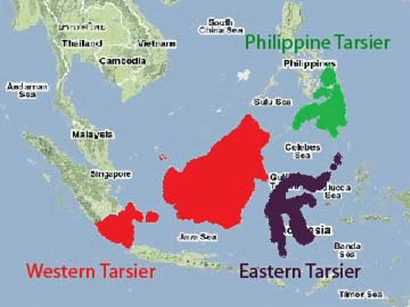
Habitat
Tarsiers rely on trees to move through an area, for sleeping, for protection from predators and to find and catch food. However, they can inhabit a range of habitats from dense forest to thick scrubland and even some type of agricultural land. Dian’s tarsiers have been found to occupy mixed-species cultivated plantations, although there have been reports of conflict with farmers and ill-health related to pesticides. Small forest coffee gardens have been found to have a positive effect on tarsier population densities. However, tarsier group sizes and population densities are highest in undisturbed forest areas, suggesting that this is the best habitat for their needs.
The Philippine and Western tarsiers are mainly described as lowland species, but have also been seen to inhabit lower montane forests. The western tarsier is known to range above 900 meters in uplands as well as its usual lowland habitats. Belitung tarsiers have been found to ultimately prefer primary forest, but with human influences very apparent on their island they have become adaptable to secondary forests and plantation areas, as long as there is suitable undergrowth available. The Philippine tarsier has been found in a range of habitats including early-mid successional forests (forests made up of relatively young species undergoing change), agroforestry areas, lowland forests and mountainous forests up to 800 meters.
The majority of the Eastern tarsiers have been found to inhabit a range of habitats at different levels, with the exception of the pygmy tarsier, which is restricted to high elevation forests over 1,600 meters – a height at which no other eastern tarsier species can be found. Tarsiers have generally been found to cling to trees at around 2 - 3 meters from the ground, at the right level to both avoid ground based predators and to intercept their prey. As tarsiers are dependent upon forests and thick scrublands they are threatened by habitat loss through logging, slash and burn clearances and agricultural practices.
Continue on page 3
|
|

Siau Island tarsier. © Geoff Deehan
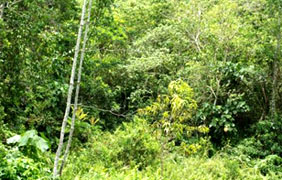
Habitat of tarsier. © Pierre Fidenci
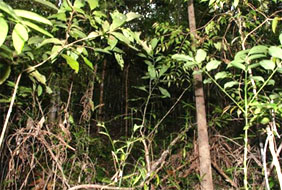
Tarsiers can be observed at night. © Pierre Fidenci
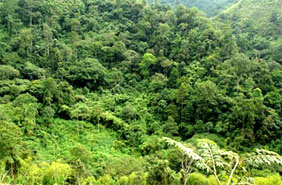
Tarsier species can occupy a range of habitats including early-mid successional and primary forests. © Pierre Fidenci
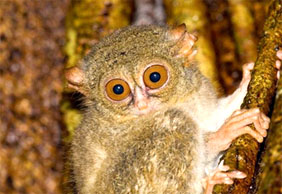
A spectral tarsier. © Paddy Ryan
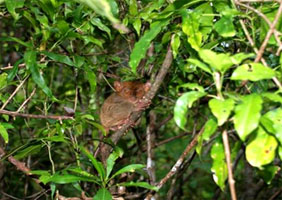
A Philippine tarsier observed in its natural habitat. © Pierre Fidenci
|









